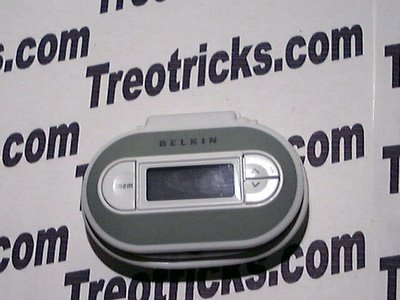
I came up with this idea yesterday along with another real good one. I still have to test the other one, so you guys will probably see it next year but it's very useful and very easy! also woking on optimizing the antenna, making an internal antenna and a bunch of other stuff.
It seems many people are using the Treo 650 for their audio needs. This is great since the Treo 650 has great potential as an audio device, but it does needs some help. It also doesn't help that the CEO chooses to use an ipod instead of optimizing the Treo or his favorite Palm, the Lifedrive, but that is another story.
So, some people out there are using an FM transmitter, but to get it to work, you need to use a 2.5mm male to 3.5mm female stereo adapter AND some also need to use an audio coupler adapter like the one Seidio sells online. Just because you have audio out it does not mean that the FM Transmitter will work as a speakerphone, so test it to make sure.
I had an Belkin adapter around so I tested it via my 3.5mm audio jack and it worked, but not as a speakerphone like some of the other people were using it for, so I needed this hack.
The tools needed for the job are:
- Small Phillips head screwdriver.
- Small wire cutters.
- Soldering tool.
- Light duty rosin core solder.
- 1000 ohm resistors, 2X.
- Ohm meter.
The solution seems simple according to the forums on the internet, but I don't like adapters and refuse to use them. I then came up with the idea to take apart the Belkin FM Transmitter and add resistors to decrease the impedance the Treo sees to get it to work.
What you need as far as impedance (resistance) for any device to work propery is 500 ohms or less between ground and both channels, indicated by the red arrows for the right channel and blue for the left channel. White is the usual color used to indicate left channel, but it does not show up too well in pictures. I tested the FM Transmitter and got a reading of 1000 ohms. To decrease it to 500, just solder in resistors of 1000 ohms in parallel. For other devices that show very high resistance, like my powered speakers @ 10k ohms, just use 500 ohm resistors.
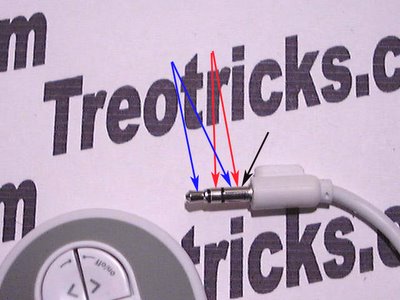
This solution would mean no adapter for me. It took me less than 10 minutes to do this hack since I had the soldering station and the right resistors by my side. You should also change the connector to a 2.5mm one if you are just using the FM Transmitter on the Treo... or do my 3.5mm Audio Jack Hack.
First thing you need to do is take apart your FM Transmitter. Just take off the battery cover, the batteries and remove the phillips head screw indicated by the red arrow in the picture below.
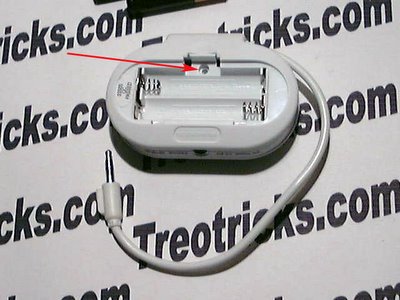
After removing the screw, split the two halves apart as shown below. You should not have to disassembly any further but you could for ease of soldering.
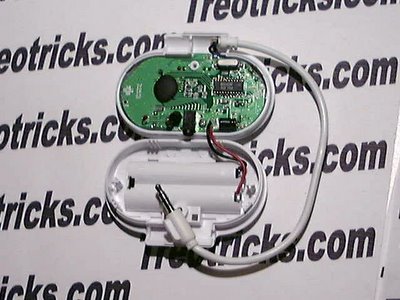
Now you need to solder in the resistors in between ground and the left channel, shown in blue in the picture below. You also need a resistor between ground and the right channel, shown in red below. Place the resistor for the left channel on top and place the one for the right channel between the board and the casing.
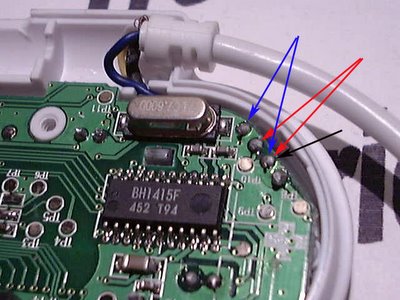
Put the FM Transmitter back together and that is it. Test it for audio and for speakerphone use to make sure that it works.
You can do this hack on almost any audio device like powered speakers, bluetooth audio transmitter, casette tape adapter, etc...
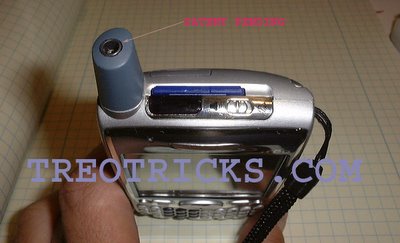


3 Comments:
Lookin Good! but its just gota record to SD doesn't it? I guess mVoice in a pinch but I'll bet you have a better Idea!
SMOKIN!!
does this allow you to use bluetooth while the fm transmitter is plugged in? Would this also work with an audio patch cable going directly to an AUX IN to a car stereo?
Lee
Does this enable you to use bluetooth while the transmitter is still plugged in? Also, would this work on just a plain audio patch cable , plugged directly in to the AUX IN jack in a car?
thanks,
Lee
Post a Comment
<< Home